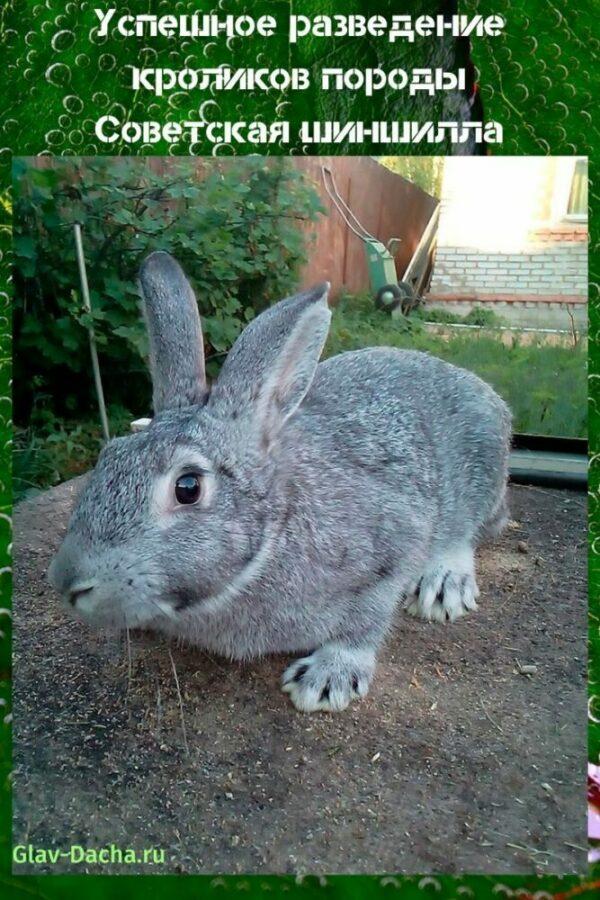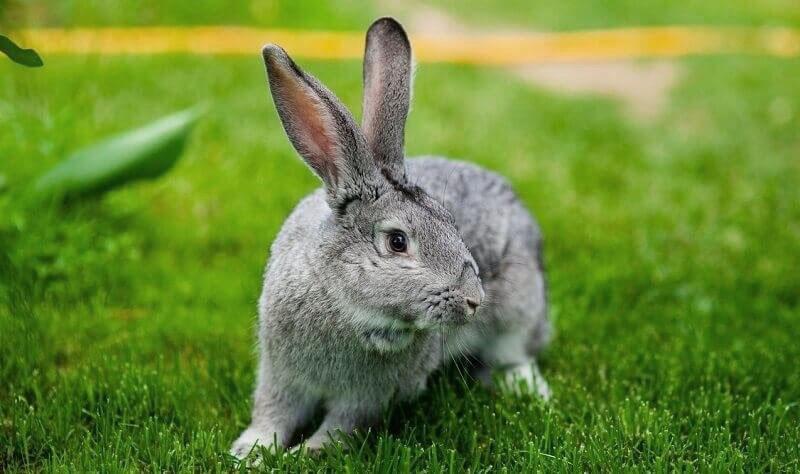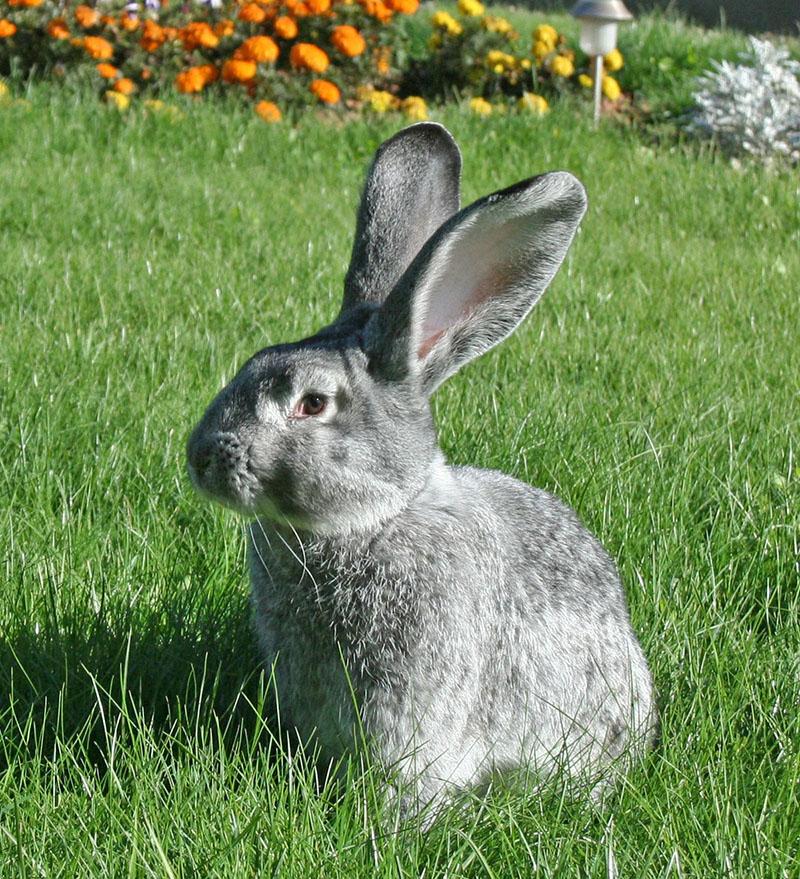Successful breeding of rabbits of the Soviet chinchilla breed
 The Soviet chinchilla is one of the most popular and demanded breeds of rabbits, attracting the attention of Russian farmers and breeders for its unpretentious care and excellent meat and skin characteristics. Breeding rabbits Soviet chinchilla requires knowledge of the basic rules and intricacies of keeping these animals. As a result, the breeder can get not only luxurious fur, from which almost all fur products in Russia are made, but also nutritious, dietary meat. Affectionate and calm rabbits make excellent decorative pets.
The Soviet chinchilla is one of the most popular and demanded breeds of rabbits, attracting the attention of Russian farmers and breeders for its unpretentious care and excellent meat and skin characteristics. Breeding rabbits Soviet chinchilla requires knowledge of the basic rules and intricacies of keeping these animals. As a result, the breeder can get not only luxurious fur, from which almost all fur products in Russia are made, but also nutritious, dietary meat. Affectionate and calm rabbits make excellent decorative pets.
Breeding history

A few years later, as a result of the work of British breeders, chinchillas were crossed with giant rabbits. This made it possible to obtain individuals with fur resembling chinchilla and a large build, weighing up to 4-4.5 kg.
Soon, domestic specialists took up breeding work. They set themselves the goal of developing a breed of rabbits with high-quality fur, high productivity and resistance to negative weather conditions. Thus, the Chinchilla rabbits were bred, adapted for breeding in any regions of Russia.
Features of the Soviet chinchilla breed
 Rabbits Soviet chinchilla are among the most popular domestic breeds, in demand due to their versatility and unpretentious care. They are raised both for valuable fur and dietary meat, and can play the role of a funny pet.
Rabbits Soviet chinchilla are among the most popular domestic breeds, in demand due to their versatility and unpretentious care. They are raised both for valuable fur and dietary meat, and can play the role of a funny pet.
Description of the breed of rabbits Soviet chinchilla:
- The constitution is compact and powerful, up to 60-65 cm long. The skeleton is well developed, the back is slightly oblong, rounded.
- The ribcage is wide and strong enough, its girth is about 35-45 cm.
- Paws strong and straight, well muscled.
- The ears are erect, small in size.
- The eyes are brown in color, with burgundy shades, rarely blue.
- The fur is very thick and soft, silvery-bluish in color.
- There is a black "rim" on the contour of the ears and the tip of the tail.
The body weight of an adult Soviet chinchilla rabbit is 6-8 kg. The weight of an animal depends on its diet and living conditions.
 Among the representatives of this breed, silver-gray color with a slight bluish tint prevails. In this case, the abdomen and lower half of the paws are most often much lighter, and the contour of the ears and the tip of the tail are covered with dark, black hairs.
Among the representatives of this breed, silver-gray color with a slight bluish tint prevails. In this case, the abdomen and lower half of the paws are most often much lighter, and the contour of the ears and the tip of the tail are covered with dark, black hairs.
Breeding rabbits Soviet chinchilla
 Large size, excellent fur, resistance to cold climates, rapid growth and active reproduction have made this species popular both in small private farms and among large breeders.
Large size, excellent fur, resistance to cold climates, rapid growth and active reproduction have made this species popular both in small private farms and among large breeders.
To breed rabbits Soviet chinchilla, it is necessary to take care of comfortable conditions for the animals - to prepare and equip cages or rabbitries, to provide them with adequate nutrition and maintain hygiene.
Rabbits are bred in three ways - in cages, aviaries or pits. Each of these methods has its own characteristics, advantages and disadvantages.
Preparation and arrangement of the cage
 For breeding rabbits, the Soviet chinchilla must be prepared cells not less than 3-4 sq. m. Animals need sufficient space for physical activity, otherwise they develop joint diseases.
For breeding rabbits, the Soviet chinchilla must be prepared cells not less than 3-4 sq. m. Animals need sufficient space for physical activity, otherwise they develop joint diseases.
Place the cages in a warm place away from drafts and direct sunlight. The optimum temperature for keeping rabbits is from + 4 ° C to + 24 ° C. It is best to use wooden structures with mesh and slatted floors to remove faeces, or a straw bed with a tin frame.
Feeders and drinkers should be attached along the walls of the cage. Separately, a queen cell with a nest for okrol is built. It can be either built-in or removable. In the cold season, cells need to be transferred to a barn. They can be installed in tiers, on top of each other.
It is necessary to remove the cells at least once every 2 days. In this case, it is necessary not only to remove waste, but also to completely change the litter.
Every 3 months the cage should be disinfected with bleach solution or by baking.
Content in aviaries
 The method of keeping animals of the Soviet Chinchilla breed in open-air cages is suitable for regions with a warm climate and mild winters. In this case, the rabbits can be grazed. But it should be borne in mind that they belong to burrowing animals and can "do" digging.
The method of keeping animals of the Soviet Chinchilla breed in open-air cages is suitable for regions with a warm climate and mild winters. In this case, the rabbits can be grazed. But it should be borne in mind that they belong to burrowing animals and can "do" digging.
For the enclosure, it is necessary to prepare a flat area covered with grass. Above the aviary should be covered with an awning to shelter animals from the rain and the scorching sun. From the side you need to attach the feeders.
The floor of the aviary should be lined with metal mesh or the walls should be reinforced with slate - this will protect the aviary from burrows and burrows of rabbits. The advantage of open-air cages is that there is no need for daily cleaning of droppings. Among the disadvantages is the uncontrolled reproduction of animals.
Content in the pits
 Keeping rabbits in pits is most often used when raising animals for meat, since it negatively affects the quality of the fur.
Keeping rabbits in pits is most often used when raising animals for meat, since it negatively affects the quality of the fur.
Key Features:
- the floor in the pit is covered with metal mesh or straw;
- walls should be lined with sheets of slate or other material that the animals cannot gnaw;
- drinkers and feeders should be placed along the pit;
- the pit must be covered to protect it from precipitation and predatory animals.
When rabbits are kept in pits, it is impossible to control their reproduction and to breed thoroughbred animals for a tribe.
Feeding rabbits Soviet chinchilla
 Food for rabbits of the Soviet chinchilla breed should be high-calorie and balanced.
Food for rabbits of the Soviet chinchilla breed should be high-calorie and balanced.
The diet of animals must include:
- parsley, dill and other greens;
- fruit and vegetable peels;
- silage;
- fresh vegetables;
- hay and straw;
- herbal flour;
- branches;
- fish and meat and bone meal;
- salt;
- concentrated feed.
 Also, the diet of rabbits must include foods that are sources of fiber - corn, lentils, peas, beans. It is useful for the animals to give wheat, rye, barley, oats, soy.
Also, the diet of rabbits must include foods that are sources of fiber - corn, lentils, peas, beans. It is useful for the animals to give wheat, rye, barley, oats, soy.
The rabbit's delicate digestive system does not assimilate certain foods - these include red cabbage, mushrooms, tomatoes, honey, granulated sugar, iceberg lettuce leaves.
Rabbit productivity
 The Soviet chinchilla is one of the most productive breeds of rabbits. Each rabbit has up to 4-6 litters. In most cases, there are 6-8 rabbits in a litter, the weight of which does not exceed 100-120 g.
The Soviet chinchilla is one of the most productive breeds of rabbits. Each rabbit has up to 4-6 litters. In most cases, there are 6-8 rabbits in a litter, the weight of which does not exceed 100-120 g.
Rabbits grow very quickly. After 10-12 weeks, their weight is about 2.8-3 kg. At the same time, for 1 kg of body weight of the animal, the breeder will have to spend no more than 2.5-3 kg of feed. Ease and unpretentious care allows increasing the number of rabbitry by 30-40 individuals from each rabbit.
 The Soviet chinchilla is a versatile breed that is great for both novice rabbit breeders and experienced breeders. Fluffy animals are distinguished by their endurance, resistance to cold weather and fertility.Subject to all the intricacies of care, you can get high quality, valuable meat and luxurious fur.
The Soviet chinchilla is a versatile breed that is great for both novice rabbit breeders and experienced breeders. Fluffy animals are distinguished by their endurance, resistance to cold weather and fertility.Subject to all the intricacies of care, you can get high quality, valuable meat and luxurious fur.